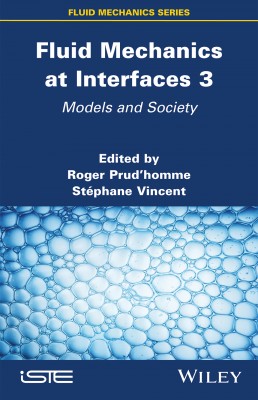
Interfaces are present in most fluid mechanics problems. They not only denote phase separations and boundary conditions, but also thin flames and discontinuity waves. Fluid Mechanics at Interfaces 3 firstly positions models as relative to applications (i.e. pollution, drops for propulsion, wind power, etc.), then emphasizes the importance of social consequences.
Chapter 1 examines the questions raised by simulation of a pollutant’s concentration degradation in permanent 2D flow using the finite element method. Chapter 2 considers an approximate analytical solution for mixed injection regimes, which acts on drop vaporization frequency response. Chapter 3 examines the case of an incompressible external flow of uniform speed at infinity, leading the liquid in the drop by friction. Chapter 4 gives a summary of combustion-based weapons and their effects. Chapter 5 then looks at the shifting interface in spacetime. Chapter 6 limits itself to two key concepts: the first is that of capillary interfaces where surface tension is present even at equilibrium, the second is that of thin flames which only exist outside of equilibrium, but which can be considered as generalized interfaces. Chapter 7 challenges the idea of constituents of matter, leading to radically transforming chemistry. Chapter 8 is concerned by the modeling of partial wetting by macroscopic approach in discrete mechanics. Chapter 9 states a numerical method of finished differences, making it possible to calculate the variables describing an average flow. Chapter 10 considers circulation in the vessels of the human body. Chapter 11 contributes by generalizing the classical series solution for initial boundary value problems of the 1D reaction-diffusion equations on any finite interval of the real line.
1. Simulation of a Pollutant’s Concentration Degradation in Permanent Two-Dimensional Flow Using the Finite Element Method, Deo Mwelwa, David Ilunga and Jean-Paul Katond Mbay.
2. Drop Vaporization Frequency Response: An Approximate Analytical Solution for Mixed Injection Regimes, Kwassi Anani, Roger Prud’homme and Mahouton Norbert Hounkonnou.
3. Considerations about the Hill Vortex, Roger Prud'homme.
4. The Fire of Weapons, Roger Prud'homme.
5. Shifting Interface in Spacetime, Roger Prud'homme.
6. The Interest of Microgravity for the Study of Fluid Interfaces, Roger Prud'homme and Kwassi Anani.
7. Fire–Air: A Story of the Flame, Roger Prud’homme, Mahouton Norbert Hounkonnou and Guillaume Legros.
8. Modelization of Partial Wetting by Macroscopic Approach in Discrete Mechanics, Jean-Paul Caltagirone and Roger Prud’homme.
9. Numerical Simulation of an Average Flow in an Inter-Blade Channel of a Horizontal Axis Wind Mill, Delphin Tomboravo, Roger Vony, Francis Raveloson and Tsialefitry Aly Saandy.
10. Circulation in the Vessels of the Human Body, Roger Prud’homme, François Boustani and Stéphane Vincent.
11. Series Solutions to Boundary Value Problems for Reaction–Diffusion Equations on Finite Intervals: Application to Stefan Problems, Edoh Tossou, Kwassi Anani and Roger Prud’homme.
Roger Prud’homme is Emeritus Research Director at CNRS, France. His most recent research topics have included flames, two-phase flows and the modeling of fluid interfaces.
Stéphane Vincent is Professor at Gustave Eiffel University, France. He leads the Heat and Mass Transfer team of the MSME laboratory. His research focuses on models and numerical methods for multiphase flows.